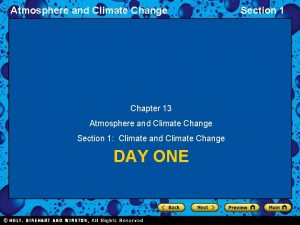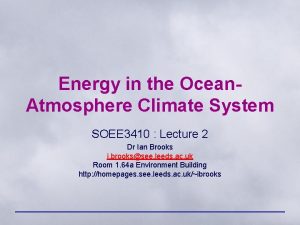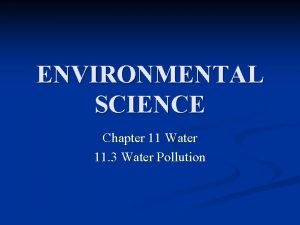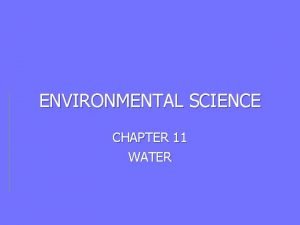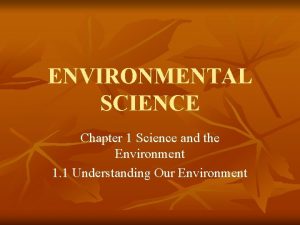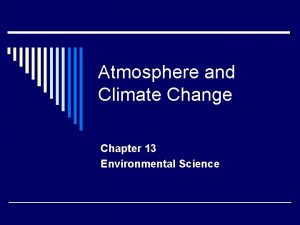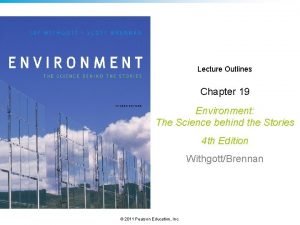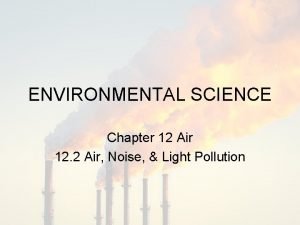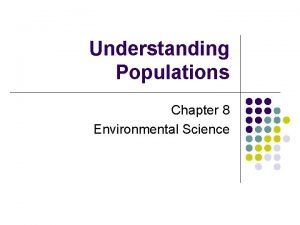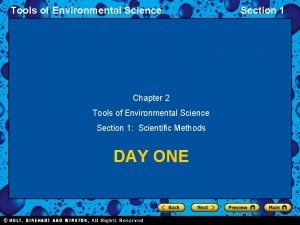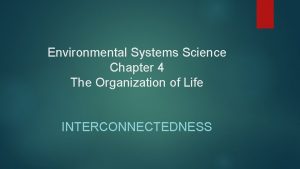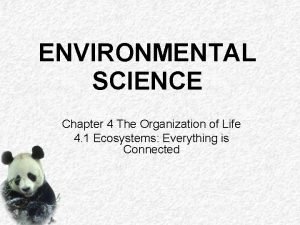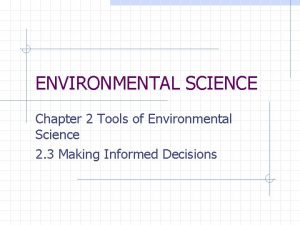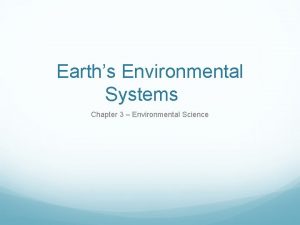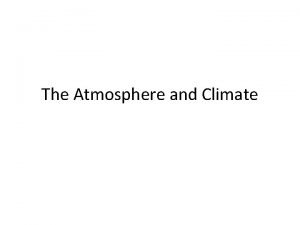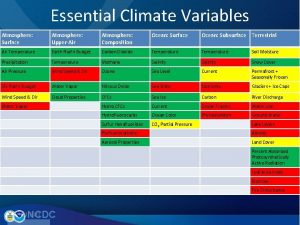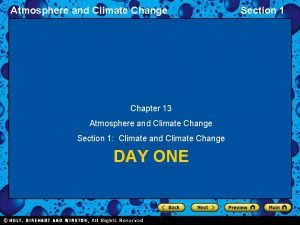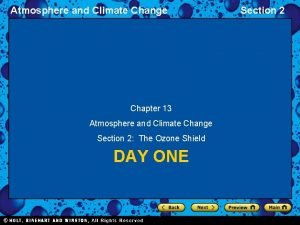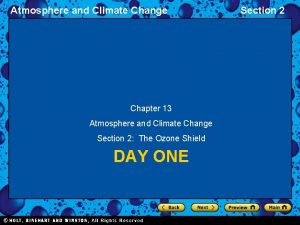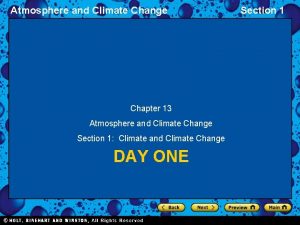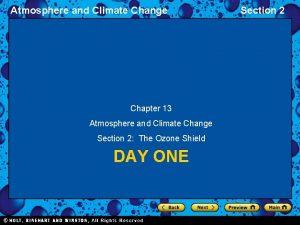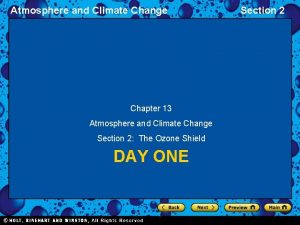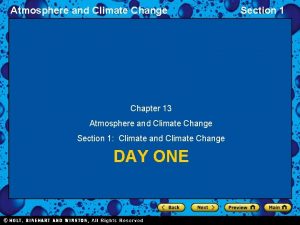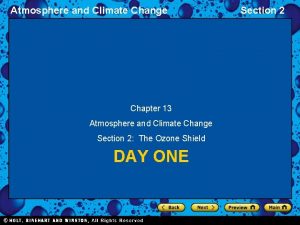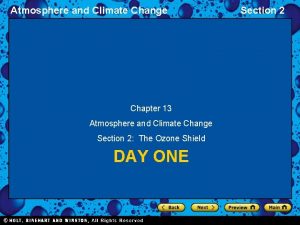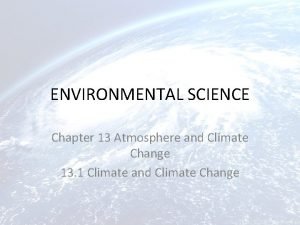ENVIRONMENTAL SCIENCE Chapter 13 Atmosphere and Climate Change





















- Slides: 21

ENVIRONMENTAL SCIENCE Chapter 13 Atmosphere and Climate Change 13. 2 The Ozone Shield

13. 2 The Ozone Shield Objectives • Explain how the ozone layer shields the Earth from much of the sun’s harmful radiation. • Explain how chlorofluorocarbons damage the ozone layer. • Explain the process by which the ozone hole forms. • Describe the damaging effects of ultraviolet radiation. • Explain why the threat to the ozone layer is still continuing today.

The Ozone Shield • The ozone layer is the layer of the atmosphere at an altitude of 15 to 40 km in which ozone absorbs ultraviolet solar radiation. • Ozone is a molecule made of three oxygen atoms. • UV light is harmful to organisms because it can damage the genetic material in living cells. • By shielding the Earth’s surface from most of the sun’s UV light, the ozone in the stratosphere acts like a sunscreen for the Earth’s inhabitants.

Chemicals That Cause Ozone Depletion • Chlorofluorocarbons (CFCs) are hydrocarbons in which some or all of the hydrogen atoms are replaced by chlorine and fluorine. • They are used in coolants for refrigerators and air conditioners and in cleaning solvents. • They were also used as a propellant in spray cans of everyday products such as deodorants, insecticides, and paint. • Their use is now restricted because they destroy ozone molecules in the stratosphere.

Chemicals That Cause Ozone Depletion • At the Earth’s surface, CFCs are chemically stable. • They do not combine with other chemicals or break down into other substances. • But, CFC molecules break apart high in the stratosphere, where UV radiation is absorbed. • Once CFC molecules break apart, parts of the CFC molecules destroy the protective ozone.

Chemicals That Cause Ozone Depletion • Each CFC molecule contains from one to four chlorine atoms, and scientists have estimated that a single chlorine atom in the CFC structure can destroy 100, 000 ozone molecule.

The Ozone Hole • In 1985, studies by scientists working in Antarctica revealed that the ozone layer above the South Pole had thinned by 50 to 98 percent. • The ozone hole is a thinning of stratospheric ozone that occurs over the poles during the spring. • This was the first news of the hole, and was published in an article in the scientific journal Nature.

The Ozone Hole • After the results were published, NASA scientists reviewed data that had been sent to Earth by the Nimbus 7 weather satellite. • They were able to see the first signs of ozone thinning in the data from 1979. • Although the concentration of ozone fluctuated during the year, the data showed a growing hole. • Ozone levels over the Arctic have decreased as well. • In March 1997, ozone levels over part of Canada were 45 percent below normal.

The Ozone Hole

How Does the Ozone Hole Form? • During the dark polar winter, strong circulating winds over Antarctica, called the polar vortex, isolate cold air from surrounding warmer air. • The air within the vortex grows extremely cold. • Polar stratospheric clouds are clouds that form at altitudes of about 21, 000 m during the Arctic and Antarctic winter or early spring, when air temperatures drop below – 80°C.

How Does the Ozone Hole Form? • You may be thinking, “If ozone is also being produced as air pollution, why does this ozone not repair the ozone hole in the stratosphere? ” • The answer is that ozone is very chemically reactive. • Ozone produced by pollution breaks down or combines with other substances in the troposphere long before it can reach the stratosphere to replace ozone that is being destroyed.

Effects of Ozone Thinning on Humans • As the amount of ozone in the stratosphere decreases, more UV light is able to pass through the atmosphere and reach Earth’s surface. • UV light is dangerous to living things because it damages DNA, the genetic material that contains the information that determines inherited characteristics. • Exposure to UV light makes the body more susceptible to skin cancer, and may cause other damaging effects to the human body.

Effects of Ozone Thinning on Humans

Effects of Ozone Thinning on Animals and Plants • High levels of UV light can kill single-celled organisms called phytoplankton that live near the surface of he ocean. • The loss of phytoplankton could disrupt ocean food chains and reduce fish harvests. • In addition, a reduction in the number of phytoplankton would cause an increase in the amount of carbon dioxide in the atmosphere.

Effects of Ozone Thinning on Animals and Plants • Scientists believe that increased UV light could be especially damaging for amphibians, such as toads, because they lay eggs that lack shells in the shallow water of ponds and streams. • UV light at natural levels kills many eggs of some species by damaging unprotected DNA. • Higher UV levels might kill more eggs and put amphibian populations at risk.

Effects of Ozone Thinning on Animals and Plants • In fact, ecologists often use the health of amphibian populations as an indicator of environmental change due to the environmental sensitivity of these creatures. • UV light can damage plants by interfering with photosynthesis. • This damage can lower crop yields.

Effects of Ozone Thinning on Animals and Plants

Protecting the Ozone Layer • In 1987, a group of nations made an agreement, called the Montreal Protocol, to sharply limit their production of CFCs. • At a second conference in Copenhagen, Denmark in 1992, developed countries agreed to eliminate most CFCs by 1995. • The United States pledged to ban all substances that pose a significant danger to the ozone layer by the year 2000.

Protecting the Ozone Layer • After developed countries banned most uses of CFCs, chemical companies developed CFC replacements. • Aerosol cans no longer uses CFCs as propellants, and air conditioners are becoming CFC free. • Because many countries were involved and decided to control CFCs, many people consider ozone protection an international environmental success story.

Protecting the Ozone Layer

Protecting the Ozone Layer • However, the battle to protect the ozone layer is not over. • CFC molecules remain active in the stratosphere for 60 to 120 years. • CFCs released 30 years ago are still destroying ozone today, so it will be many years before the ozone layer completely recovers.
 Climate change 2014 mitigation of climate change
Climate change 2014 mitigation of climate change Atmosphere
Atmosphere Chapter 13 atmosphere and climate change
Chapter 13 atmosphere and climate change Ocean smallest to largest
Ocean smallest to largest Ocean atmosphere and climate
Ocean atmosphere and climate Why environmental science is an interdisciplinary science
Why environmental science is an interdisciplinary science Climate change meaning and definition
Climate change meaning and definition Favorite subject is science
Favorite subject is science Objectives of water pollution
Objectives of water pollution Chapter 11 review environmental science
Chapter 11 review environmental science Environmental science chapter
Environmental science chapter Environmental science chapter 13 review
Environmental science chapter 13 review Chapter 19 environmental science
Chapter 19 environmental science Chapter 2 economics and environmental policy
Chapter 2 economics and environmental policy Radonrid
Radonrid Environmental science chapter 8 review answer key
Environmental science chapter 8 review answer key Environmental science section 2 review answers
Environmental science section 2 review answers The day they parachuted cats into borneo food web
The day they parachuted cats into borneo food web Chapter 4 the organization of life
Chapter 4 the organization of life Chapter 2 assessment environmental science
Chapter 2 assessment environmental science Earth's environmental systems chapter 3
Earth's environmental systems chapter 3 What are the 3 levels of biodiversity
What are the 3 levels of biodiversity


